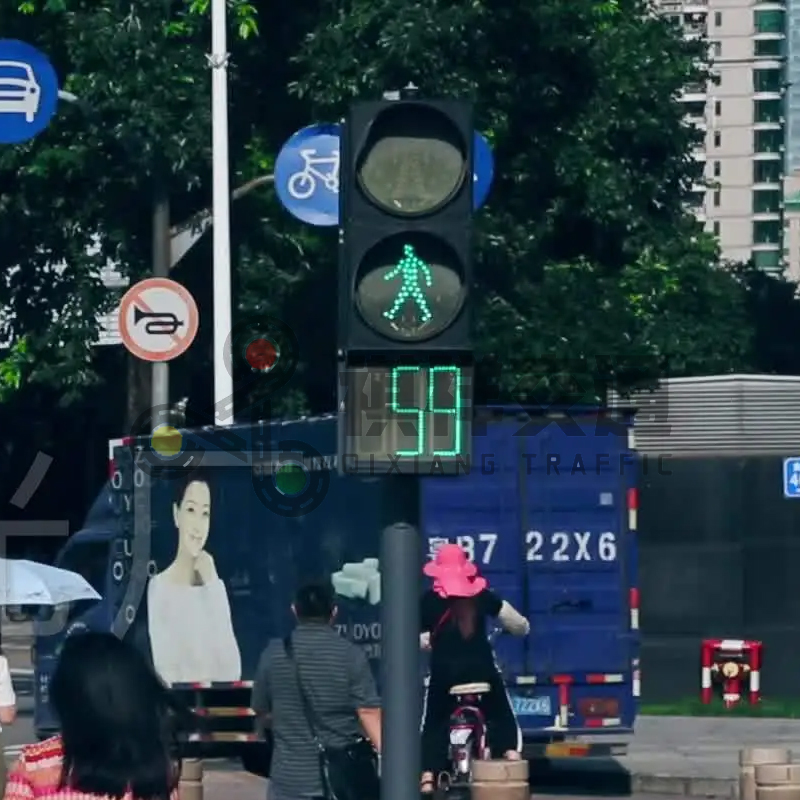Pedestrian traffic lights are an important part of urban infrastructure designed to improve safety and facilitate smooth pedestrian traffic. These lights act as visual signals, guiding pedestrians when to cross the street and ensuring their safety. The production process of pedestrian traffic lights involves multiple stages, from design and material selection to assembly and quality control. This article takes a closer look at the intricate steps involved in creating these important devices.
1. Design and planning
The production process begins with the design phase, where engineers and designers collaborate to create a functional and aesthetically pleasing pedestrian traffic light. This stage involves determining specifications such as the size, shape and color of the lamp. Designers must also consider the visibility of the signal, ensuring it can be seen clearly from a distance even in adverse weather conditions.
At this stage, technology integration must also be considered. Modern pedestrian traffic lights often include features such as countdown timers, audible signals for the visually impaired, and smart technology that can adapt to real-time traffic conditions. Designs must comply with local regulations and standards, which vary by region.
2. Material selection
Once the design is complete, the next step is to choose the right materials. Pedestrian traffic lights are typically made from durable materials that can withstand harsh environmental conditions. Common materials include:
- Aluminum: Aluminum is lightweight and corrosion-resistant, and is often used for traffic light housings.
- Polycarbonate: This material is used for lenses and offers high impact resistance and clarity.
- LED: Light-emitting diodes (LEDs) are the first choice for lighting due to their energy efficiency, longevity and brightness.
The choice of materials is crucial because not only must they meet safety standards, but they must also be cost-effective and sustainable.
3. Manufacturing components
Once the materials are selected, manufacturing of the individual components begins. This process usually involves several steps:
- Metal Fabrication: Aluminum housings are cut, formed and finished using various techniques including welding, bending and powder coating. This ensures that the case is both strong and beautiful.
- Lens Production: Polycarbonate lenses are molded into the desired shape and size. This process requires precision to ensure the lenses fit perfectly and provide optimal visibility.
- LED Assembly: LEDs are assembled onto a circuit board and then tested for functionality. This step is critical because the quality of the LED directly affects the performance of the traffic light.
4. Assembly
Once all components are manufactured, the assembly process begins. This stage involves putting the pieces together to create a fully functional pedestrian traffic light. The assembly process usually includes:
- Enclosure Assembly: The assembled aluminum enclosure is assembled with the LED circuit board and lens. This step needs to be handled with care to avoid damaging any components.
- Wiring: Install the wires to connect the LED to the power source. This step is crucial to ensure the light is working properly.
- Testing: Traffic lights undergo rigorous testing before leaving the factory to ensure they meet safety and performance standards. This includes checking the brightness of the LEDs, the functionality of any additional features, and the overall durability of the device.
5. Quality control
Quality control is an important part of the production process. Every pedestrian traffic light must meet specific standards to ensure safety and reliability. Quality control measures include:
- Visual Inspection: Visually inspect each unit for defects in materials, fit and finish.
- Functional Test: Tests whether the light is functioning properly, including signal timing and the effectiveness of any additional functions.
- Environmental Testing: Some manufacturers perform testing to simulate extreme weather conditions to ensure the lights can withstand rain, snow, and heat.
6. Packaging and distribution
Once the pedestrian traffic lights pass quality control, they are packaged for distribution. The packaging is designed to protect the lamp during shipping and storage. Manufacturers typically include installation instructions and warranty information with each device.
The distribution process involves transporting the lights to various locations, including municipalities, construction companies and traffic management agencies. Timely delivery is critical, especially for projects that require the installation of multiple traffic lights.
7. Installation and maintenance
After distribution, the final step in the pedestrian traffic light life cycle is installation. Proper installation is essential to ensure the light is functioning properly and positioned for maximum visibility. Local authorities or contractors usually handle this process.
Maintenance is also an important aspect of pedestrian traffic lights. Regular inspections and repairs are necessary to ensure that lights remain functioning properly and available for safe use by the public. This includes checking the functionality of the LED, cleaning the lens, and replacing any damaged components.
In conclusion
The production process of pedestrian traffic lights is a complex and meticulous undertaking, combining design, engineering and quality control. These lights play a vital role in city safety, guiding pedestrians and helping prevent accidents. As cities continue to grow and develop, the importance of reliable and efficient pedestrian traffic lights will only grow, making their production processes an important aspect of urban infrastructure development.
Post time: Oct-15-2024







